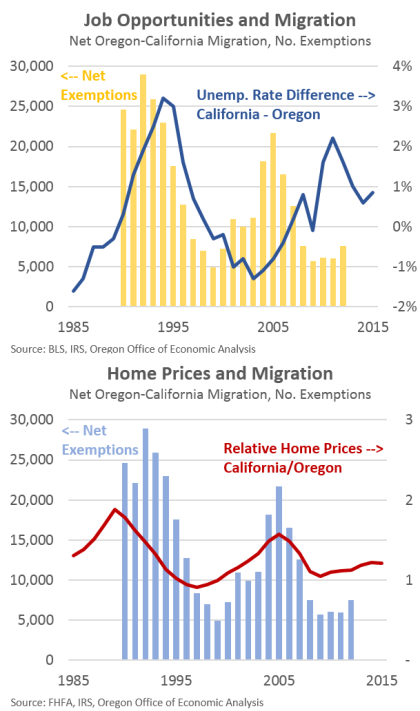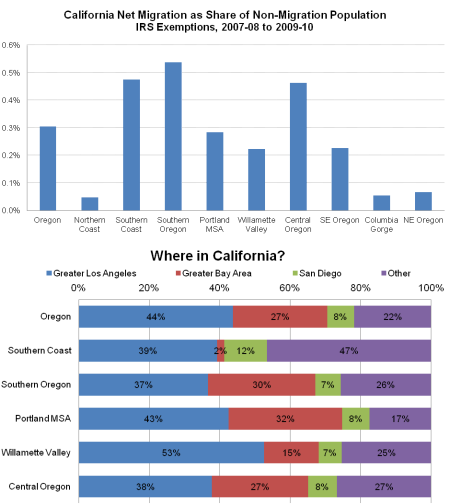Migration is vital to Oregon’s economic health. It is one of the two primary reasons Oregon outperforms the typical state during an economic expansion. The other being our industrial structure. In both good times and bad, Americans want to live in and move to Oregon. In fact, Americans have been moving to Oregon in droves since Lewis and Clark and are likely to continue to do so. Our state’s ability to attract skilled, young working age households is a huge economic benefit. We rank quite well on the brain gain spectrum (the opposite of the brain drain). There is a reason Mark’s research and presentation at last year’s Oregon Economic Forum was on the impact of migration, to both urban and rural Oregon. It is part of our economic foundation.
Yes, more migrants generally does result in stronger housing demand and yes, many of the migrants are from California, as we will discuss below. However, demand is just one component of housing costs. Thus, while there are certainly traces of truth in the underlying sentiment of the “No Californian” stickers — I also hear this at various presentations as well — the complaint, if not misguided, is certainly incomplete with a strong tinge of migration hypocrisy.
Focusing on just native born Americans, across the whole country 68% of the population lives in the same state they were born. Individuals living in Oregon today? Just 51% were born here. That’s a massive difference and mathematically works out to more than half a million “extra” migrants today in Oregon (582,300) than in typical state. In the map below, shown previously, orange and red counties have an above average share of migrants while green counties have few migrants.
As our office has been highlighting in the past couple of years, and we have an additional section in our latest forecast document, migration is picking up again. 2015 is shaping up to be as large of a year as the state saw during the housing boom. And yes, a sizable portion do come from California. Why do they come? Beyond a high quality of life, or high quality of place, migration is usually driven, economically speaking, by job opportunities and relative home prices. Where can one find a job and where can one find an affordable place to live, at least relatively speaking? Despite the rhetoric out there, Oregon when compared with our southern neighbor, ranks well along both of these lines in the past 25 years. Below are the graphs our office uses to illustrate this.
As relative job opportunities in Oregon are better (lower unemployment rate), migration is stronger and vice versus. Similarly, as home prices appreciate more quickly in California, migration into Oregon is stronger and vice versus. Note: relative home prices fit the data better over the housing bubble and Great Recession, however research has shown both to be statistically significant over time. Also the home price measure is a ratio of indexes, so a value of 1 means the indexes are the same, not that home prices are literally the same.
Where in California are many of these migrants coming from? Here it is a bit ironic that the online response has been coming from the Bay Area, since the majority of the migrants are coming from SoCal, at least last time our office dove into the county to county migration data from the IRS. Also this may be a bit different today with all the tech outposts in Portland in recent years.
Again, from an economic perspective, all of this migration into Oregon, both from California and elsewhere, is a positive development. It brings both skilled, young households who will set down roots (no, they are not all degree holding baristas) and a strong influx of retirees with a lifetime of experience and some wealth. These are good things and have been happening for the past 200 years. And for those who may prefer migrants not from California, the surrendered driver license data from the DMV shows the Californian share has been declining for the most part since the early 1990s.
For the record, while I am a transplant myself, I am not from California. I’m from the Great Plains and completed the Oregon Trail via the old route, wagon ruts and all.




You say, “…the home price measure is a ratio of indexes, so a value of 1 means the indexes are the same, not that home prices are literally the same.”
What index is it that you’re using here?
By: DNF on September 8, 2015
at 10:26 AM
I am using the Federal Housing Finance Agency (FHFA) home price index by state. That is indexed to 1980 quarter 1. Sorry for the confusion.
http://www.fhfa.gov/DataTools/Downloads/Pages/House-Price-Index.aspx
The way I read the graph is as the home price line moves higher, that means CA home prices and increasing at a faster rate than OR home prices, thus the price differential is increasing.
By: Josh Lehner on September 8, 2015
at 10:30 AM
Josh,
When I moved to Portland from Oakland CA in 1989, I did a back-of-the-envelope calculation that told me home prices in Portland were about one-third of those in Oakland and that jobs in Portland paid about two-thirds of going pay rates in Oakland. The relationship between those two factors told me that buying a home here at that time would be a great investment. But the reasons I moved to Oregon were that we were being priced out of Oakland as we needed a larger home for our family, I got a great job offer here, and we loved the quality of life and place once we visited. I expect my experience on the leading edge of the in-migration of Californians in the 1990s was fairly typical. Oh, and I brought my college degree with me, so I guess that made me typical as well.
–Tim Nesbitt
By: Tim Nesbitt on September 17, 2015
at 8:38 AM
Thanks Tim! Yes, I think you’re experience then (and others today) is pretty similar. As a state we’re better for it. One thing I would add though, is the 1/3 home price, 2/3 salary calculation to a fairly big extent has a lot to do with Bay Area home prices. Portland/Oregon home prices, relative to income back then were typical and at pretty good levels. The Bay Area has had affordability challenges for a long time, and they’re much worse today of course.
By: Josh Lehner on September 17, 2015
at 10:07 AM
Granted this is from an office whose charter is to focus on the economy but that isn’t the only metric by which we should guide our future or determine what is “good” for Oregon. Many immigrants are escaping over-developed states/regions (in California, hydrologically speaking, to the point of collapse), which is what’s driving the “Oregon looks attractive” model. In this way Oregon is just next on the list of states poised for overdevelopment and, with the belief that “this is good”, eventually our own environmental demise. Put another way: the infinite growth model, applied to any finite resource, is a proven dead end so citing economic benefits is a short term view at best. At what point then do we choose enviornment over economy?
By: Jeff hess on September 17, 2015
at 9:42 AM
Thanks Jeff; appreciate the comment and insight. You’re right, growth for growth’s sake isn’t always the best model nor can it always continue. Yes, California and much of the southwestern US has water issues and are likely/will only get worse. Cliff Mass from University of Washington has some interesting work on climate change refugees and the Pacific Northwest. However, is the reason California is seeing outflows of migrants due to over-development? Probably for some people, and moving decisions aren’t based on just one thing either, of course. However most people typically move for housing or employment related reasons, based on survey data from the Census Bureau. While parts of CA may be over-developed from a natural resource perspective, they’re certainly not over-developed from a population demand perspective, hence the high home prices. Demand to live there is very high. Again, to your broader point, it is challenging to take into account those other various factors into growth, like the environment, but Oregon’s urban growth boundaries do try to at least have that conversation.
By: Josh Lehner on September 17, 2015
at 10:14 AM
[…] lately discussing one of the two reasons Oregon outperforms the typical state during an expansion: migration. However the other reason is in full force today as well: our industrial structure and ties to […]
By: Manufacturing Employment Update | Oregon Office of Economic Analysis on September 29, 2015
at 9:08 AM
[…] more thing. Not all of these more numerous higher income households are migrants, or Californians. Some certainly are, but there is considerable movement across these income groups during the past […]
By: Portland Household Growth by Income (Housing) | Oregon Office of Economic Analysis on October 7, 2015
at 9:05 AM
[…] topics is somewhat limited here in Oregon just due to the industry’s size. Furthermore, as detailed previously, laying the blame for higher housing costs at the feet of Californians, tech-related or not, is […]
By: Graph of the Week: High-Tech Growth 2015 | Oregon Office of Economic Analysis on October 20, 2015
at 9:04 AM
[…] presentation really was a summary of recent blog posts, including the return of migration flows into Oregon, much of our household formation on net has occurred at the higher end, and whether the […]
By: Housing Forecast Takeaways | Oregon Office of Economic Analysis on November 17, 2015
at 1:43 PM
[…] growth — and migration in particular — is one of the two fundamental reasons Oregon’s economy outperforms the typical state […]
By: Oregon County Population 2015 | Oregon Office of Economic Analysis on November 19, 2015
at 10:20 AM
[…] https://oregoneconomicanalysis.com/2015/09/08/migration-in-defense-of-californians/ […]
By: Sherman County eNews #4 | Sherman County eNews on January 5, 2016
at 9:23 AM